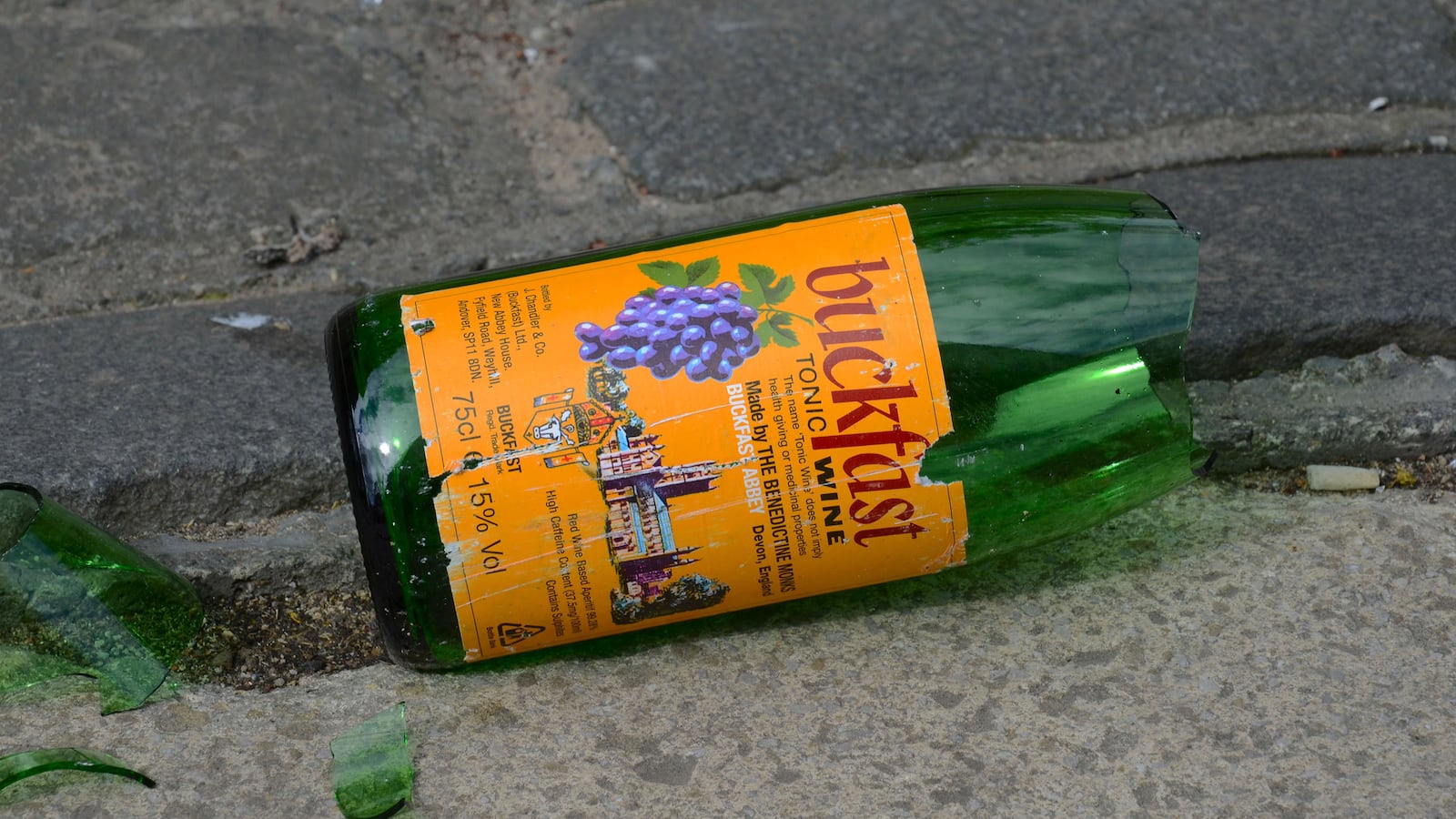We were somewhere off the coast of the Isle of Mull when the Buckfast began to take hold.
It was entirely my own fault that my boat crew was starting to feel a little lightheaded. I’d packed a bottle of the stuff and, for a laugh, used it to make a Scottish equivalent of the classic Champagne cocktail, the Kir Royale.
Conversation levels seemed to rise—as did the levels of abuse flung in my direction by those of non-Celtic persuasion on board. “What is this stuff?” one of them exclaimed. I started to explain, as I am about to do for you.
Buckfast is a “tonic wine,” and one of many tipples with ecclesiastical origins, though I should quickly disabuse you of the notion that in anyway has it ever been considered the equivalent of such noble drinks as Chartreuse, Benedictine, or Trappist beers.
According to legend, it arrived in England in 1882, when a group of Benedictine monks re-established an abbey in the quiet Devon village of Buckfast. With them they brought a supposed traditional recipe for a wine, which they began to sell as a curative. “Three small glasses a day, for good health, and lively blood,” went the sales pitch.
In 1927, a change in the law resulted in the abbey losing its license to sell alcohol and the monks began to work with a wine merchant. At this point, the wine, which was then called a “tonic,” was reformulated into the drink we know today. As late as the 1960s, it was marketed as “a splendid pick-me-up that restores zest and sparkle,” and was available at all good pharmacies. Who could resist?
Buckfast would have been little more than a footnote in the history of wine and spirits were it not for the fact that, for reasons that are still obscure, it became hugely popular, not among the picturesque villages around the abbey, but in the grim housing projects of central Scotland. It was virtually unknown anywhere else, except Ireland where it also was embraced by the urban working class. Buckfast’s prim and proper Tonic Wine became known as just, Buckie.
Today, the bottle carries the caveat “the term tonic wine does not imply health giving or medicinal properties.” Indeed, Buckie’s reputation would now be considered the opposite. It’s known by various colorful sobriquets, “wreck the hoose [house] juice,” “electric soup,” or in Ireland “Lurgan Champagne.”
In 2010, on average three crime reports per day in greater Glasgow mentioned the brand. In 2015, a Scottish Prison Service survey reported that more than 40 percent of inmates had drunk it before committing the crime that had put them in the slammer.
Why did this gentle decoction created by tender-hearted monks become the drink (and indeed on occasion weapon) of choice in central Scotland? It could be its low-cost or the fact that it packs a certain punch (30 proof).
Its fans probably don’t worry much about the potassium glycerophosphate, disodium phosphate, and sulfites it contains, though the mix of reconstituted grape must, alcohol, and, in the U.K., vanillin will certainly be more likely to grab their attention. As will the final crucial ingredient: Caffeine. A lot of caffeine.
The U.K. bottling has 25mg of caffeine per 100ml, the Irish version has 32mg per 100ml. Let’s put that in context. If you drink a bottle of Buckie you’d have consumed the equivalent of nearly six cans of Red Bull. If you had the Irish one it would be 14. Plus, of course, all the alcohol. And given the propensity for its classic signature serve being one person, one bottle, consume rapidly, you can, maybe, see where problems could arise.
Think of it as being the contemporary equivalent of Vin Tonique Mariani, that mix of Bordeaux red wine and coca leaves that appeared in the 1860s and delivered the drinker 6mg of cocaine per fluid ounce.
Given all of this, you may be surprised that I was recently drinking a Buckie cocktail with Dan Dudgeon, the head of new product development at Crucible, London’s cutting-edge creative hub/experimental distillery.
He handed me a Champagne flute filled with a so-called Bottle Rocket, a bottle-carbonated mix of pineapple, lemon, white Port, vodka, and cold-distilled Buckfast. Off-dry, light and fresh it was a cheeky aperitif, which took Buckfast away from its usual rich, sweet, heavy world.
Dudgeon then poured out a deliciously rich, fruity puree made from strawberry and Buckfast, topping it up with Leffe Abbey Beer. Monks y’see? It too worked well. “Hang on,” he says, tasting the initial mix and disappearing, bottle in hand. He reappeared a minute or so later with a cocktail glass. “A strawberry Daiquiri?” It’s even better than the first two drinks. We throw some names around. A Baquiri? A Buckeroo?
It shouldn’t be all that surprising that London hipsters are now drinking Buckfast. After all, according to that reliable source of information Wikipedia, Buckfast is enjoyed, “by the working class, students, and bohemians.” I suspect I’m witnessing the arrival of that last group. Something is happening. Buckie, once reviled is becoming hip.
I first saw this three years ago in the famously Buckie-free setting of Edinburgh (although Scotland is a small country, Glasgow and the capital city rarely share the same taste in anything). That night, however, evidence of a brief rapprochement was in the air as a Ned-Groni was pressed into my hand (“ned” being Glaswegian slang for hooligan) where the Buckie took the place of a Negroni’s usual vermouth. It was so successful, I had another.
The most prominent proselytizer for Buckfast is Crucible’s director, Stuart Bale who, surprise, like me is also a Glaswegian. “My first Buckie cocktail?” He considers the question for a second. “Probably a Velvet Elvis: Buckfast and the cheapest sparkling wine you can get. That was about 15 years ago.”
What started as a joke among west Scotland bartenders now has momentum. Under the fun and the thrill of using a seemingly transgressive ingredient, is an honest look at flavor. If it works, it works—and anyway who says cocktails should always be serious? The skill of any great bartender is breaking flavors down and discovering what is appropriate for each drink.
Today, you can get Buckie cocktails on tap in Glasgow’s Nice n’ Sleazy, while the same city’s GGs offers punters a choice of their Buckfast from the fridge or at room temperature. Bad Sports in London is also flying the flag, and there are reports of it now appearing in drinks on menus in Australia. It is steadily becoming part of a U.K. bartender’s arsenal. Even the brand’s website now improbably features recipes for 16 cocktails and 39 dishes.
Upstairs at Crucible, Romeo deWit is riffing on the caffeine theme with a Buckin’ Bronco: a kegged cocktail made from Buckfast, Merlet Coffee Liqueur and instant coffee (“it’s more consistent than ground”) with a touch of sugar, and some glycerol (“for mouth feel”).
It’s thick and rewarding, with just enough bitterness to balance the sweetness. While one is enough to get the heart racing, you know immediately this is not a session drink. On the other hand, Bale makes one with smoked raspberries, Empirical Charlene Mcgee’s juniper spirit, lemon, and Buckie, that is lightly fruity and quaffable.
Behind me, Dudgeon has put some Buckfast into a rotovap. The spirit that distils off is rough, but the extract that’s left behind is a potent concentrate of coffee, treacle, raisin, and thick black fruits. It’s burnt, but somehow also sweet. In fact, I realize, it’s similar to paxarette, the fortified wine used for seasoning sherry casks for Scotch until it was banned in 1990.
“Add a drop of this to a whisky and you’ll get this wild sherried effect,” I say to Bale. “Or,” he replies with the air of a man who has tried this already, “you could get wood chips and force them into Buckie in the ultrasonic and get a Buckfast cask effect. You can do anything.”
From being a drink, which lived under a cloud of opprobrium, Buckfast is becoming one of the most unlikely success stories of recent years, and is now conceivably one of the most profitable drinks brands in the U.K. In March 2017, yearly sales had grown to £43.2 million.
There’s a method to this apparent madness and serious thinking from some of the sharpest minds in the British drinks industry. “Why wouldn’t you use it?” asks deWit. “It’s super fruity. It works in any aperitif drink where you’d use red vermouth, Carpano Antica Formula, or Punt e Mes. The image just makes it all the more fun.”
Buckfast’s tale is one of redemption, the prodigal son returning to the bosom of its family. As for my sail off of Mull, my boatload of fools is now sailing in a slightly different, but still eccentric, course.

